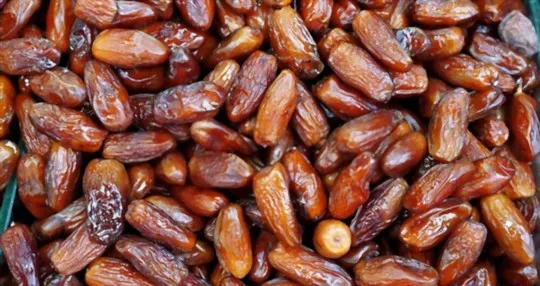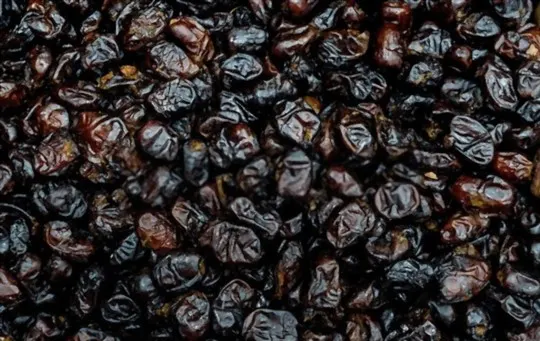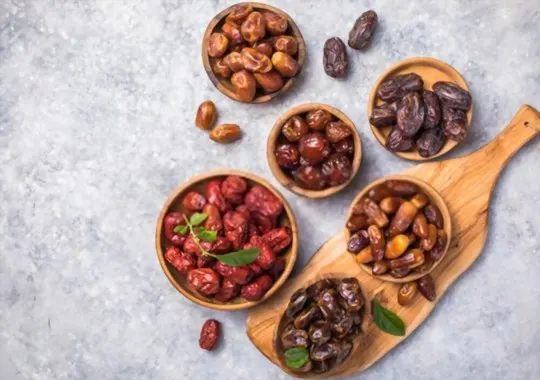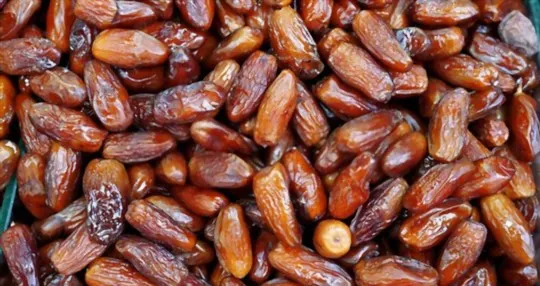Dates, they’re sweet, wrinkly, and a desert staple. Fresh dates vs dried dates – oh, the dilemma!
Each packs a nutritional punch. We can’t ignore their benefits. Seriously, those tiny fruits carry big health perks. Ever bitten into a fresh date? Juicy. Dried ones? Chewy. Two textures, one fruit.
Our kitchen escapades taught us – they’re not interchangeable. Fresh dates add moisture, dried ones, intensity. Trust, we learned the hard way. Baking disasters, anyone?
All in, this isn’t just fruit talk. It’s a tale of two dates.
What are Fresh Dates?

The term ‘Fresh Dates’ refers to the ripe and plump fruit that grows on the date palm tree.
These fruits are succulent, tender and have a juicy texture.
They can be eaten as a snack or used in various recipes due to their top-notch nutritional value.
Fresh dates have a soft exterior shell that encloses the edible flesh and a seed at the core.
Consuming fresh dates is beneficial for one’s health as they provide essential nutrients such as fibers, vitamins, minerals and enzymes.
The presence of antioxidants in them helps to fight against inflammation and reduce cell damage caused by free radicals.
Furthermore, fresh dates also aid in regulating blood sugar levels due to their low glycemic index.
One significant advantage of consuming fresh dates is that they provide instant energy without raising blood sugar levels abruptly like other sugary snacks do.
They help you maintain your energy levels throughout the day and keep you feeling full for an extended period.
What are Dried Dates?

Dried dates are a type of fruit that has been dehydrated to extend its shelf life.
These dates are commonly used in desserts and baking recipes as they have a sweet and caramel-like flavor.
Drying removes the moisture content from the fresh fruit, leaving it with a wrinkled and chewy texture.
The process of drying the dates also enhances their nutritional value by concentrating their essential minerals and fiber content.
Compared to fresh dates, dried ones have a longer shelf life and can be stored for up to a year without refrigeration.
Dried dates also have a higher concentration of sugar than fresh ones, which makes them ideal for sweetening dishes naturally.
However, they also have a higher calorie count due to the sugar content.
Differences Between Fresh Dates and Dried Dates

When comparing fresh dates and dried dates, there are distinct differences between these two types of fruit.
Fresh dates are typically softer and have a higher moisture content than their dried counterparts.
Dried dates, as the name suggests, have been through a dehydration process that removes most of their water content.
This results in a longer shelf life and concentrated sweetness.
Moisture Content and Texture
The quality of dates is a significant concern that impacts their taste and applicability in different recipes.
One critical aspect to consider is the level of moisture content and texture.
This factor significantly affects how fresh or dry the fruit can feel, ultimately influencing how the consumers use them.
Regarding moisture content, fresh dates tend to have more water content than their dried counterparts.
Fresh dates are generally juicier, with a softer texture that makes them ideal for direct consumption as snacks or in smoothies.
Conversely, drying process significantly reduces the fruit’s water content, results in firmer flesh and chewier texture that make them appropriate for baking and cooking.
It’s worth mentioning that the variation in moisture content also contributes to differences in shelf-life between fresh and dried dates.
The lack of moisture in dry dates makes them less perishable than their juicy counterparts, enabling long-term storage without refrigeration.
However, this does not mean inferior quality for either option, but only a matter of preference based on usage demand.
Sugar Concentration and Sweetness
Fresh dates and dried dates have differences in sugar concentration and sweetness levels.
Fresh dates are harvested when they are still unripe, containing less sugar and a lower glycemic index compared to dried dates that have been dehydrated, thus, increasing their sugar concentration.
Dried dates tend to be sweeter and have higher sugar levels than fresh ones due to the removal of water content during the drying process.
The sweetness level also varies depending on the type of date variety.
Medjool is often considered the sweetest while Deglet Noor has a milder sweetness.
Moreover, it is important to note that consuming too many dates can lead to an increase in blood sugar levels, especially for those with diabetes or insulin resistance.
Therefore, it is essential to consume them in moderation and as part of a balanced diet.
Understanding the differences between fresh and dried dates’ sugar concentration and sweetness can help individuals make informed choices when incorporating them into their meals or snacks.
Flavor Profile
The taste of dates can vary depending on their state, whether fresh or dried.
Dried dates tend to have a more intense and concentrated sweetness due to the removal of moisture.
On the other hand, fresh dates are milder in flavor with a crisp texture and less sticky consistency.
Overall, the difference in flavor profile between fresh and dried dates can be attributed to the moisture content and processing methods used during preparation.
When it comes to dried dates, the drying process amplifies their natural sugar content resulting in a sweeter taste than their fresh counterparts.
The drying process also improves shelf life while intensifying flavors such as caramel undertones.
As for fresh dates, their mildness makes them more versatile for culinary use, allowing them to blend more easily into dishes without overpowering other ingredients.
It’s noteworthy that some people actually prefer the less overpowering taste of fresh dates over dried ones.
Fresh dates are often enjoyed as snacks or used as toppings for salads or porridge, while dried dates are suitable for baking and adding sweetness to recipes calling for sugar.
Ultimately, it’s important to experiment with both types of dates and see which one best suits your tastes and cooking needs.
Nutritional Differences
The nutritional disparity between fresh and dried dates is significant.
Fresh dates are a rich source of vitamins like B6, A, C and potassium, while dried dates possess increased fibre content across similar micronutrient spectra.
Additionally, dried dates’ glycemic index is lower than fresh ones, hence causing slower digestion.
Fresh dates vs Dried dates nutritional differences are notable.
While fresh ones contain higher levels of vitamins that contribute to optimal physiological functions like blood clotting, collagen production as well as eye health promotion, the dried variety is appreciated for its minimal supply of calories – useful in weight management- soluble fiber content that aids in digestive regularity, and Vitamin K which enhances bone metabolism.
In comparison with many other snacks filled with preservatives and high sugar quantities whose consumption contributes to several disorders like diabetes and hypertension, both date varieties present natural healthy options.
A diverse range of beneficial nutrients distinguishes both classes of dates’ consumption further.
For example; where the relative macronutrient distribution tends more towards carbohydrates in regular uptake of dried or fresh types, infrequent consumption can lead to unique advantages such as high antioxidant ingestion as well as improved metabolism.
Similarities Between Fresh Dates and Dried Dates

Fresh and dried dates share many commonalities.
Both types of dates belong to the same family, have a similar nutritional profile, and are packed with essential vitamins and minerals.
Dried dates come from fresh dates and undergo dehydration, which removes water but also intensifies their sweetness.
Although they differ in texture and taste, both types of dates can be consumed as-is or used in cooking and baking for added flavor and nutrition.
In terms of dietary value, both are low in fat, high in fiber, potassium, magnesium, vitamin B6; however, dried dates contain more calories per serving than fresh ones due to their concentrated natural sugars.
Culinary Uses of Fresh Dates and Dried Dates
Fresh and dried dates can be used in various ways in different cuisines.
These nutritious fruits are known for their versatility and delicious taste.
When it comes to culinary uses, fresh dates are commonly used for making jams, chutneys, and desserts due to their moisture content and delicate texture.
On the other hand, dried dates have a chewy and dense texture which makes them perfect for baking recipes, energy bars, and savory dishes like stews or tagines.
Apart from these common uses, fresh dates can also be stuffed with cheese or nuts to make an exotic appetizer.
Dried dates can be blended into a paste and used as a natural sweetener in smoothies or sauces.
They can also be soaked overnight to soften them up before blending with nuts or oats to make homemade granola bars.
How to Select and Store Fresh Dates and Dried Dates?
Selecting and storing dates correctly is essential to obtain maximum flavor and freshness from both fresh and dried varieties.
Here’s how you can ensure the optimal quality of your dates.
For Fresh Dates:
- Choose plump, unblemished fruits with smooth skin.
- Avoid dates with wrinkled or damaged skin, as they may already be spoiled.
- Store them in an airtight container in the fridge.
- Fresh dates will last up to two weeks when refrigerated properly.
For Dried Dates:
- Look for packages with intact fruits that are soft and moist but not overly sticky.
- Avoid packages with signs of mold or crystallization on the surface of the fruit.
- Dried dates have a longer shelf life than fresh ones but may occasionally become rancid or dry.
- To keep them fresh for an extended period, store them in an airtight container in a cool, dark place.
It’s worth noting that while fresh and dried dates are both delicious, they do differ in taste, texture, and nutritional content.
Fresh dates have a slightly more delicate flavor profile than their chewy counterparts.
On the other hand, dried dates often have higher nutrient density because their dehydration removes excess water content thereby keeping concentrated nutrients intact.
Always check product labelling for additional information concerning key ingredients.
Conclusion
The differences between fresh dates and dried dates are quite distinct.
Fresh dates are perishable fruits that should be eaten soon after harvesting, while dried dates can last for months without spoiling.
In terms of taste, dried dates are sweeter and have a chewy texture compared to the soft and juicy flesh of fresh dates.
Another significant difference is their shelf life, as dried dates have a long storage period and can be used in many ways–like making date syrup or as an ingredient in fruit bars.
Nonetheless, both types of dates provide essential nutrients such as fiber, potassium, iron and so on.

Leave a comment